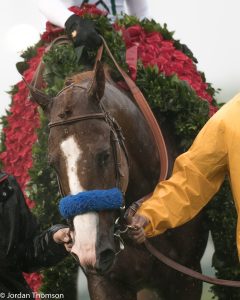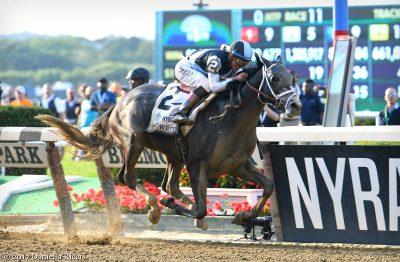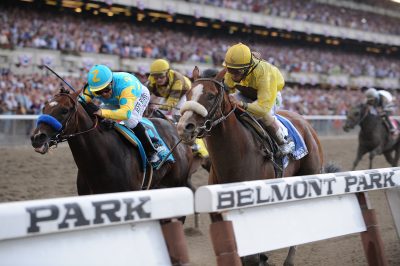
Justify (photo by Jordan Thomson).
When it comes to handicapping the 2018 Belmont Stakes, inevitably, the first question most handicappers will have to ask themselves is: Am I for Justify or are am I against him?
If you are a racing fan, the answer to that question probably will be “yes,” you want to see another Triple Crown winner. If you are a bettor, however, the answer to that key question probably could be, would be, and should be “no,” you will be betting against the favorite.
The Belmont Stakes is one of the great unheralded graveyards for favorites in all of horseracing. It has become increasingly more difficult for a horse that has already won or even competed in both of the first two legs of the Triple Crown to win the Belmont Stakes. Because of this, no matter how good the favorite might look in the Belmont Stakes, it is still worthwhile — from a handicapping and wagering standpoint — to bet against them.
Favorites are not enjoying a good run in the Belmont Stakes recently, notwithstanding Triple Crown winner American Pharoah. In 2017, Tapwrit won the Belmont and paid $12.60 in a race that featured neither the Kentucky Derby nor the Preakness winner. In 2016, Creator won the Belmont Stakes and paid $34.80. The favorite that year was Preakness winner Exaggerator at 7-5. He finished 11th. The second and third favorites, Suddenbreakingnews and Stradivari, finished ninth and fifth.

Tapwrit (photo by Daniella Ricci).
As a matter of fact, when Union Rags won the Belmont Stakes six years, he was the lowest-paying Belmont winner in recent memory (other than American Pharoah). Union Rags paid $7.50 to win as the second choice behind that year’s favorite, Dullahan.
Part of the reason favorites are doing badly is because the favorites are usually horses that are coming into the Belmont after having run in the Kentucky Derby and Preakness. And the Preakness, in particular, has become a negative key race for the Belmont Stakes.
Dating back to Commendable in 2000, 10 of the last 18 Belmont Stakes winners had not run a race in the five weeks in between the Kentucky Derby and Belmont. When you narrow it to four weeks out from the Belmont to accommodate horses exiting the local Belmont prep race in the Peter Pan, then 12 of the last 18 Belmont winners had at least a four-week layoff going into the Belmont.
Recent Belmont winners — including Tapwrit, Creator, Palace Malace, Union Rags, Summer Bird, Jazil, Birdstone, Empire Maker and Commendable — had all run in the Kentucky Derby, but skipped the Preakness in favor of other methods of readying for the Belmont Stakes. Filly Rags to Riches had no race between the Kentucky Oaks and the Belmont.
The 2014 Belmont winner Tonalist and 2010 Belmont winner Drosselmeyer hadn’t run in either the Kentucky Derby or Preakness, but did have a race in between in the Peter Pan. They won the Belmont off four-week layoffs. Lemon Drop Kid, like Tonalist and Drosselmeyer, ran in the Peter Pan Stakes in-between the Derby and Belmont, but didn’t win. The Peter Pan has proven to be an effective Belmont Stakes prep in recent history and is a good place to look for a longshot. This year that contender would be Peter Pan winner, Blended Citizen, trained by Doug O’Neill.

Union Rags edges past Paynter in the late stages of the 2012 Belmont Stakes (photo via NYRA).
Belmont Stakes winners of yore usually were war horses that danced every dance in the Triple Crown series, but that’s no longer the trend to look for in a Belmont winner. A quintet of recent winners of the Belmont Stakes were making their Triple Crown debuts in the Belmont Stakes, including Tonalist in 2014, Drosselmeyer in 2010, Da’ Tara in 2008, Rags to Riches in 2007 and Sarava in 2002.
This year, the favorite and distant second-favorite, Justify and Bravazo, will be the only two horses in this Belmont Stakes exiting both the Kentucky Derby and Preakness. So, if you are not going to bet the favorite(s) in the Belmont, and you are not going to bet the two horses in the race that ran in both the Derby and Preakness, you will be avoiding Justify and Bravazo and, instead, will be landing on relatively high-priced horses — no matter who you like.
But even if you are betting against Justify and Bravazo, you will still need to narrow down the contenders much more than that in order to come up with a Belmont Stakes pick. Therefore, let’s take a closer look at some trends in the Belmont Stakes that specifically deal with running style to see if we can come up with the best horses to bet in Saturday’s third jewel of racing’s Triple Crown.
Bet Tactical Speed and Middle Movers Instead of Deep Closers
It may be hard to erase the memory of Victory Gallop’s late rally to beat Real Quiet in the1998 Belmont Stakes, and who could ever forget Birdstone’s late run that denied Smarty Jones a Triple Crown in 2004? Nevertheless, besides these and very few other exceptions, it has been tough sledding through the years for deep closers in the Belmont Stakes, contrary to what most people might think.
When handicappers consider the Belmont Stakes’ 1 1/2-mile distance, most assume that deep-closing horses that had come up short at lesser distances in the Kentucky Derby and Preakness would be at an advantage in the Belmont Stakes thanks to the race’s extra furlong worth of real estate. This way of thinking has been a misconception in recent years. In truth, pace horses, stalkers and late runners who can move into striking distance by the quarter pole have a big edge over the one-run closers that must come from far back in the field to make up the necessary ground in the stretch.
People often consider horses like Jazil, Sarava, Lemon Drop Kid and Editor’s Note to be horses that won the Belmont Stakes thanks to deep closing late runs through the stretch. A closer look at all of those winners, however, reveals something different. All four of those Belmont winners, and several other closing winners in the history of the Belmont Stakes, had already made up the majority of their ground before the stretch run, and were already within 1 1/2-lengths of the lead at the quarter pole on their way to victory.
Afleet Alex was more of an actual closer and was still four lengths behind the leader at the quarter pold en route to his Belmont win in 2005. Creator was also an exception on 2016. He closed from far back and even though he had made up the majority of his ground before the quarter pole, he was still three lengths behind the lead turning into the stretch.
When evaluating Belmont Stakes contenders based on their running styles, keep in mind that there have been many more on- or near-the-pace winners of the Belmont Stakes than far-behind winners of the Belmont through the years. And that axiom remains true today in spite of a few high-profile exceptions.
The recent trend strongly favors horses that are able to stay close to the pace in the Belmont Stakes, or at least run in the front half of the field. Tapwrit won the 2017 Belmont from just two lengths off the pace after the opening half-mile and Da’ Tara won the 2008 Belmont going wire-to-wire. The 2011 Belmont winner, Ruler On Ice, pressed Shackleford in second all the way before taking charge in the stretch. In 2010, Drosselmeyer came from mid-pack. Union Rags raced in the front-half of the field throughout, laying no more than four lengths off the pace at any point in the race. Palace Malice laid close to the pace early, running fifth at the first call and fourth at the second call en route to victory. Tonalist had a similar running style in 2014, laying sixth but only three lengths back in the early stages of the race and, then, pressing from third, just a length behind, the rest of the way before getting up by a head in the late stages.
If you do decide to put your money on a closer in the Belmont, try to make sure the late runner will be able to launch his rally on the backstretch and make his way up close to the lead by the time the field reaches the quarter pole.
See the chart below for a breakdown of the most recent Belmont Stakes winners:

Box the Outside Posts in Exactas
Most handicappers completely disregard post positions as having any impact whatsoever in the outcome of the Belmont Stakes. After all, the Belmont Stakes is such a long race that what happens at the start would logically have very little impact on the running of the race, right? Well, not so fast. As it turns out, very few factors seemingly have had as much to do with winning and losing in recent editions of the Belmont Stakes as post positions have had.
So why are post positions so important in the Belmont, you ask? Well, for starters, the Belmont Stakes features the shortest run into the first turn of any of the three Triple Crown races, and secondly, the horses breaking from inside posts run much more of a risk of getting squeezed back early than the outside horses do. With a shorter run to the first turn and more of a benefit to horses with tactical speed in the Belmont than in other races, early trouble can cost a horse its best chance in the Belmont much more readily than it can hurt a horse’s chances in most other races. Just ask Big Brown, who had tons of early trouble before the first turn of the 2008 Belmont Stakes and was never able to recover, eventually pulling up.
The recent post position numbers for the Belmont Stakes are telling — and they all favor horses breaking from outside posts. Nine of the 17 Belmont Stakes winners from 2001 to 2017 broke from posts 7 and outward, not to mention that one of the years that a horse from an outside post didn’t win was in 2006 when there were only six horses in the race — in other words, there were no outside horses. This means nine of the last 16 Belmont Stakes with more than six entrants have been won by outside horses. It also should be noted that American Pharoah from post five was in the outside half of what was only a nine-horse field in 2015.
In fact, counting last year’s Belmont Stakes winner Tapwrit, who broke from post 13, and 2014 winner Tonalist, who broke from post 11, five of the 17 most recent Belmont winners broke from the widest post in the field, including Rags to Riches in 2007, Sarava at 70-1 odds in 2002 and Point Given in 2001. Plus, the 2013 winner, Palace Malice, broke from post 12 in a 14-horse field.
Final Thoughts
Whether you are approaching this year’s Belmont Stakes first and foremost as a racing fan, or as a handicapper and bettor, we hope you enjoy the race as Justify attempts to make history by becoming horseracing’s 13th Triple Crown winner. Use each of these angles and betting strategies when handicapping and betting on the Belmont Stakes, and you will increase your chances of winning. Enjoy the third jewel of the Triple Crown, and best of luck on Belmont Stakes Day!



